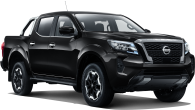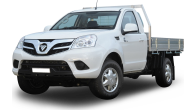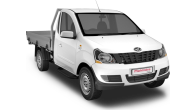Isuzu has invested more than four million kilometres and six years of development in creating the all-new third-generation of its D-Max ute. And feedback from the Australian market had significant influence in its design, given that Australia is the D-Max’s largest global export market behind Thailand.
Isuzu is characterised by pragmatism in new model development, that embraces steady evolution over revolution. Consistent with that approach, it has significantly raised the bar with the latest D-Max, which has been redesigned and modernised from the ground up without compromising its traditional strengths.
The New D-Max offers 20 variants comprising three cabin types and four model grades, with significant chassis, drivetrain, equipment and safety enhancements. We recently tested an entry-level model to see how it measures up in the hotly-contested tradie ute wars.
Isuzu D-MAX 2021: Sx (4X2)
| Engine Type | Diesel Turbo 4, 3.0L |
|---|---|
| Fuel Type | Diesel |
| Fuel Efficiency | 8.0L/100km (combined) |
| Seating | 2 |
| Price From | $22,440 - $27,720 |
| Safety Rating |
|
Price and Features – Does it represent good value for the price? What features does it come with?
Our Mineral White test vehicle is the 4x4 dual cab-chassis in work-focused SX model grade, which with the standard issue 3.0 litre four-cylinder turbo-diesel engine and six-speed torque converter automatic is priced at RRP$48,700.
It's also fitted with numerous Isuzu genuine accessories including a heavy-duty aluminium tray ($2367), alloy slide-out drawer ($325), towing kit with 12-pin plug ($1309) and tinted bonnet protector ($199) resulting in a total as-tested RRP of $52,900.
.jpg)
From its 17-inch steel wheels and 255/65R17 tyres to its fabric seat trim, wipe-clean vinyl floor, urethane steering wheel and other hard-wearing surfaces, there’s no doubt you’re stepping aboard the most utilitarian model that’s been honed for hard work.
.jpg)
However, it does have useful creature comforts like a new height-and-reach adjustable steering column, automatic rain-sensing wipers, air-conditioning with adjustable vents for rear seat passengers, a customisable driver’s MID and a four-speaker multimedia system with 7.0-inch display screen, voice recognition, DAB+ radio, Android Auto/wireless Apple Car Play.
There’s also a rear-step bumper which incorporates a reversing camera (a feature not commonly found on cab-chassis vehicles) and safety sensors. This model also comes standard with a heavy-duty rear suspension package, new locking rear differential and more.
Design – is there anything interesting about its design?
The new D-Max has a 30mm increase in wheelbase from the previous model’s 3095mm to 3125mm, resulting in improved directional stability. It also has a lower roof-line and the ute variant (with style-side tub) is slightly shorter and wider. Increased ground clearance and reduced front and rear overhangs result in improved approach, ramp-over and departure angles, while wading depth has increased to an impressive 800mm.
Isuzu claims it’s the strongest, lightest and safest ute it’s ever built due largely to extensive use of high-tensile steel, which offers four times the strength of conventional mild steel at a fraction of the weight. The new truck-style ladder-frame chassis and wind tunnel-developed body (with less aero drag) are therefore stronger yet lighter. Roof reinforcement has more than doubled too, with a payload rating of up to 100kg.
.jpg)
There are also bigger front disc brakes inside larger and wider 17-inch wheels and tyres, redesigned double-wishbone front suspension with improved handling dynamics, revised leaf-spring rear suspension with less unsprung weight and increased wheel travel, new electric power-assisted speed-sensitive steering and one of the tightest turning circles in its class at 12.5 metres.
The SX’s interior has lots of black and grey with minimal chrome as you’d expect at base level, but the front seats are supportive and well-bolstered around the shoulders, rib cage and hips without being too restrictive.
.jpg)
Front and rear entry is assisted by sturdy grab handles on the A and B pillars and rear passengers also benefit from wider door openings, a more reclined seating position and more room. Even the dreaded centre rear seat can take a tall adult without their head pressing into the roof lining like numerous rivals.
Our only gripes are the absence of volume dial adjustment on the infotainment screen, as the buttons on the screen and steering wheel take too long to respond. And there’s inadequate storage in the rear doors (see Practicality section).
Engine and transmission – What are the key stats for the engine and transmission?
Standard across all models is the new Euro 5-compliant 4JJ3-TCX 3.0-litre four-cylinder turbo-diesel. True to Isuzu tradition, it’s an extensive evolution of the previous model’s 4JJ1-TC, which won many loyal buyers in Australia due to its robust design and appetite for hard work, particularly when towing.
The end result is 140kW at 3600rpm and 450Nm between 1600-2600rpm. These figures not only represent useful gains of 10kW and 20Nm but ample mid-range torque where you need it most, with 300Nm from as low as 1000rpm and 400Nm available across a broad 1850rpm band width from 1400-3250rpm. That’s seriously good flexibility.
.jpg)
The Aisin-built AWE6B45 II six-speed automatic transmission, with its fuel-saving torque converter lock-up from third to sixth gear and intelligent uphill/downhill shift protocols has also evolved, with a new automatic transmission fluid pan and integral cooler/warmer to optimise fluid life. Auto-shifting is also smoother and faster with the option of sequential manual-shifting, which is ideal for eliminating gear-hunting when hauling and/or towing heavy loads in hilly terrain.
The revised transfer case in the dual-range, part-time 4x4 system allows faster engagement between modes and there’s a smoother-running and stronger one-piece aluminium tail-shaft. The equally new electromagnetic rear diff lock, which simultaneously disengages the electronic traction control and stability control systems, can be engaged without stopping.
Fuel consumption – How much fuel does it consume?
Isuzu claims an official combined figure of 8.0L/100km and the dash readout was showing 10.5 at the end of our 580km test, which comprised more than 100km under maximum payload and otherwise mostly stop-start city and suburban driving.
Our figure calculated from actual fuel bowser and tripmeter readings was slightly higher again at 11.3, which means you could expect a realistic urban driving range of around 670km from its 76-litre tank.
Practicality – How practical is the space inside?
Our test vehicle in bare cab-chassis form has a 1910kg kerb weight and 3100kg GVM, which results in a 1190kg payload rating. However, the addition of the tray, drawer and towing kit increases the kerb weight by 269kg, which lowers the payload by the same amount to 921kg.
It's also rated to tow up to 3500kg of braked trailer but with a 5950kg GCM (or how much it can legally carry and tow at the same time), that would leave only 271kg of payload capacity; the bulk of which could easily be used up - or exceeded by - a crew of four.
.jpg)
Anecdotally at least, most ute owners tow less than 3000kg so it would be better for owners to base the towing limit on the 3100kg GVM, which drops the peak tow rating from 3500kg to a still substantial 2850kg and gives you back the maximum 921kg payload.
The heavy-duty aluminium tray, which at 1800mm is 150mm longer than the previous model, is squeak and rattle-free with a robust headboard frame and rear window protection, 12 inboard load anchorage points and four sturdy rope rails underneath.
Cabin storage includes a large-bottle holder and narrow storage bin in each front door, pop-out cupholders on each side of the dash, shallow storage tray in the centre of the dash-pad, single glovebox with open storage nook above and overhead glasses holder. The console offers more open storage, two small-bottle/cup holders and a lidded box which doubles as a contoured driver’s elbow rest.
Each rear door has a large-bottle holder but minimal loose item storage. And there are no pouches on the front seat backrests nor a fold-down centre armrest with twin cup-holders as found in higher grades, so storage for rear passengers is limited. However, the 70/30 split seat bases can swing up and be stored vertically to allow more internal cargo space or access two underfloor storage compartments.
What’s it like as a daily driver?
It has easy entry/exit and there’s plenty of adjustability between the seat and steering wheel to allow most drivers to find a comfortable position. All-round vision is good and although the left footrest is well positioned it only supports the outer half of a big Aussie boot, so it could be a tad wider.
Driving unladen or with light loads reveals the firmness of the standard heavy-duty rear suspension, particularly with the tyres inflated to the higher 300kpa pressures recommended for heavy load carrying. Even so, it maintains the D-Max’s signature solidity, combined with nicely weighted and responsive electric power steering, strong braking and neutral handling that feels firmly planted on the road.
The engine and automatic transmission feel refined and capable and generally do their best work when left alone. Highway performance is low-stressed and fuel-efficient, fairly loafing along with only 1500rpm at 100km/h and 1600rpm at 110km/h.
Our only criticism is the over-sensitive response of some features in the Intelligent Driver Assistance System (IDAS), namely Autonomous Emergency Braking (AEB) and Forward Collision Warning (FCW). On numerous occasions, both of these systems did not trust the judgement of a driver with four decades of accident-free experience and activated when they were clearly not required. We’ve not experienced this level of sensitivity in similarly-equipped ute rivals.
What’s it like for tradie use?
We loaded 800kg into the tray which with driver equalled a payload of 900kg that was just under the 921kg limit. The heavy-duty rear leaf springs compressed less than 40mm with more than 60mm of static bump-stop clearance remaining, which is the largest clearance we’ve seen in this class of vehicle.
Needless to say, such a big increase in sprung weight dramatically improved the ride quality which felt supple yet disciplined, floating over large bumps and tracking straight over myriad road irregularities on a notoriously bumpy test route.
.jpg)
There was no noticeable decline in engine performance, braking or steering response either and the intelligent auto’s eagerness to exploit engine-braking, by downshifting as soon as braking was applied on downhills, was always appreciated. Overall, a very competent load hauler, just like its ancestors.
Warranty & Safety Rating
Safety – What safety equipment is fitted? What safety rating?
Maximum five-star ANCAP rating tested against the most stringent 2020 criteria is a huge advance over previous generations.
Even so, front and rear parking sensors are notable omissions in our test vehicle. Cutting-edge safety is highlighted by eight airbags, AEB, adaptive cruise control, traffic sign recognition, lane departure warning, blind-spot monitoring, rear cross-traffic alert, trailer sway control, reversing camera and many more.
Rear seat also has two top-tether and ISOFIX child seat anchorage points on the two outer seating positions.
.jpg)
Ownership – What does it cost to own? What warranty is offered?
The D-Max is cover by a six years/150,000km warranty and up to seven years of roadside assistance if serviced at a participating Isuzu Ute dealer.
Scheduled servicing intervals of 15,000km/12 months whichever occurs first. Total capped-price servicing cost of $3373 covers the first seven scheduled services.
Verdict
The latest D-MAX is a substantial and effective evolution of the previous generation, even though some of the new driver aids could probably benefit from some fine-tuning. Even so, we’re sure that its rock-solid build quality, surefooted handling, outstanding load-carrying ability and cutting-edge safety will make an even more compelling argument for D-MAX ownership in the decade or more to come.
Pricing Guides







.jpg)
.jpg)
.jpg)
.jpg)
.jpg)
.jpg)












.jpg)


.jpg)
